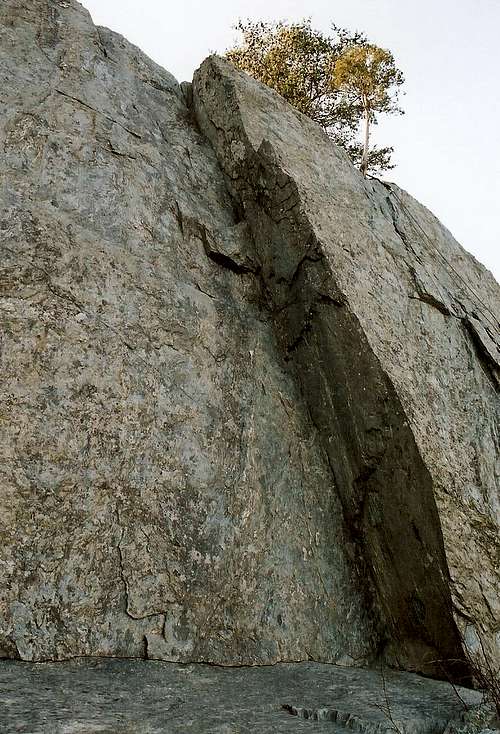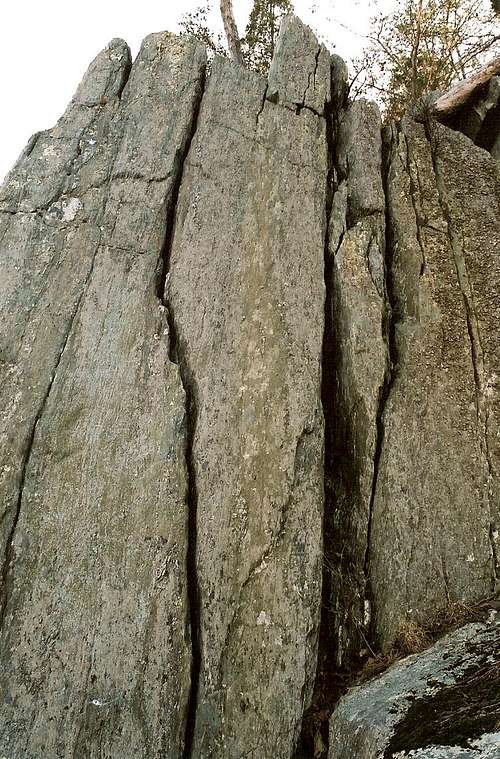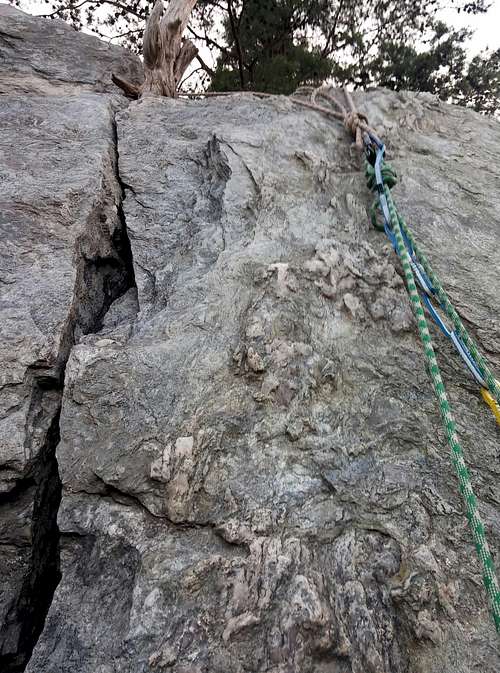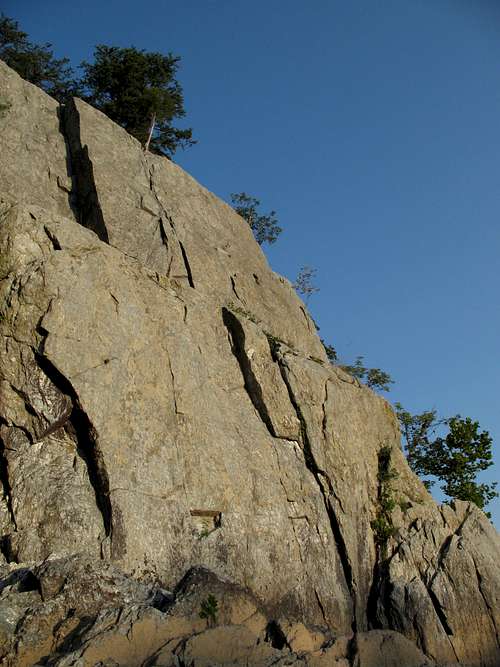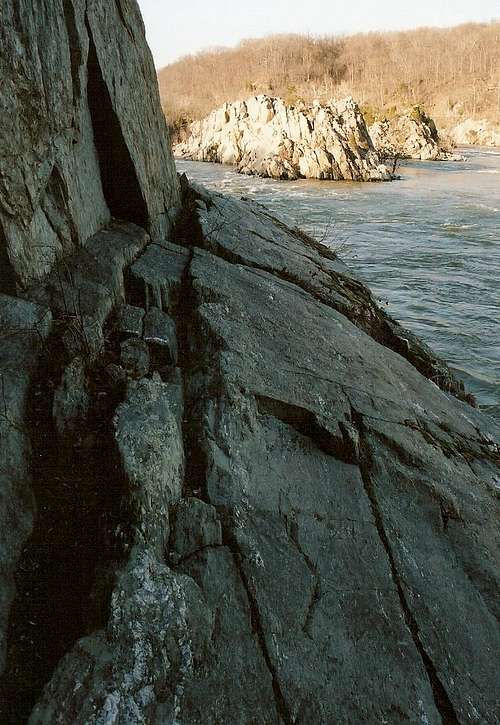-
 12659 Hits
12659 Hits
-
 89.39% Score
89.39% Score
-
 29 Votes
29 Votes
|
|
Mountain/Rock |
|---|---|
|
|
38.99181°N / 77.2485°W |
|
|
Trad Climbing, Toprope |
|
|
Spring, Summer, Fall, Winter |
|
|
149 ft / 45 m |
|
|
Overview
The third major climbing area downstream from the overlooks at Great Falls Park (after, in order, Sandbox and Dihedrals, Juliet’s balcony is another Great Falls crag that has the roiling Potomac River directly at its base. The crag gets its name from the prominent ledge that lies about halfway between the river and the clifftops. Several routes begin from the Balcony and climb 25-30’, but there are some that begin directly from the base and go all the way up, effectively doubling the climbing height (these begin from blocks along the river). The named routes range from 5.0 to 5.10d, so there is something for everyone at this popular spot. The routes may be pretty short, but that means you can climb several of them, maybe even all, in one day. Although you are not likely to find a beautiful and willing young woman at the top of this Juliet’s Balcony, you should find plenty of fun and challenge.An excellent resource for the area is Eric Horst’s Rock Climbing Virginia, Maryland, and West Virginia. The section on Great Falls provides one-sentence overviews of the routes. There are also photos, taken either from a boat or from the Maryland side, of the crags, and the photos have useful diagrams showing the locations and directions of the routes. The guide leaves the step-by-step concerns, and the fun, to you.
Even better is the PATC Climbers' Guide, which focuses just on the Great Falls area.
Navigating the Crag
There are 4 main sections here. Routes are listed from left to right as one faces them.
Upstream Face
Some of the climbs offer enough natural protection to allow lead climbing, but most climbers employ toproping here and elsewhere in the park, especially since the access trail leads to the tops of the cliffs rather than to their bases.
The attached pictures, if you click on them, will provide more details about the crag and some of the routes on it.
From the western part of I-495, a piece of the Capital Beltway, take Exit 44 for Route 193, Georgetown Pike; this is the second exit south of the Maryland border. Drive west for a few miles until you see the well-signed road leading to Great Falls Park. Turn right and follow the road about a mile to the entrance station. There are two large parking lots after the entrance station. However, make an immediate right instead and drive into the "Lower Lot," which is popular with climbers and kayakers and closer to the crags.
To reach Juliet’s Balcony, hike to the River Trail, which is the maintained trail closest to the river. After passing the Sandbox and Dihedrals access points, the trail drops down some wooden steps, makes a bridged stream crossing, and then climbs a set of wooden steps. At the top of the climb, the trail splits in three, with the River Trail heading right. The left fork just goes a few feet to a rocky overlook of the river (scrambling opportunities here). Go straight, though, up to the rock outcrop directly ahead of you. Once there, you will be atop the Juliet’s Balcony crag. Look down to view the Balcony just to make sure you’re in the right place. From the parking lot, it takes around 15 minutes to hike here.
Then there are a few ways to access the climbs. To reach Epigone and Sciolist, make a short scramble down the upstream side of the cliff. There is a photo of these routes on this page, so they should be easy to find. Both climb the upstream-facing wall that marks one end of the Juliet’s Balcony crag, and both begin from a gently sloping ledge; no river exposure on these two climbs.
These climbs range from 25' to 50'.
* Missing Years (5.5)
* Mantlepiece (5.10d)
* Sciolist (5.10d)-- It's not 5.10 if you use the left edge. If you use the crack near the left edge, it's more like 5.10a.
* Epigone (5.6)-- a short route and not over the river, but it's a beautiful crack and makes a good lead. Easy for a 5.6 if you know how to jam.
* Sneakers (5.4)
Upper Wall
This is where most of the climbing happens. The climbs are about 35'.
* Capulet (5.8)-- Short, tricky start, interesting but nothing exciting.
* Balcony Corner (5.6)-- like most other climbs here, this has a tricky start.
* Balcony Arete (5.9-)-- Start is hard. This would be 10a or 10b many other places.
* Left of Left Stuff (5.8)-- Can be done without using any holds on Left Stuff.
* Left Stuff (5.7)-- popular route good for leading or toproping; begins from the Balcony and climbs the obvious crack up the middle of the wall. The start is stiff, but the rest is an easy, beautiful crack. Probably no more than 5.2 after the start.
* Right Stuff (5.7)-- starts about 5' right of Left Stuff. The start is tough on this one, too, and feels a little harder than 5.7, but once you're past the crux start, the rest is pretty easy though tougher than the rest of Left Stuff.
Lower Wall
These climbs are only accessible at lower water levels. Either rappel down or scramble over from the bottom of Trellis. Each climb is about 30' (Trellis is 50' but is left of the two walls); some can be paired with a climb on the upper wall if one sets the anchor well, enabling climbs of 65' or more and thus some of the longest to be found at Great Falls.
* Trellis (5.0)-- popular as a descent and return route. Also an easy lead. I don't think I've ever seen anyone toprope this one. This climb is also excellent for scramblers. Head just downstream from the main cliff and look for an obvious break. Class 4 scrambling will get you down this break, across a gully (the base of Trellis), and then up onto the Balcony. If this Class 4 downclimbing does not appeal to you, head a bit further downstream and look for a wider, gentler break. Climb the gully and crack system on the left. Near the top, you have two choices: continue the same way, which will take you through a short move requiring pretty much only your arms; or cut right on a sloping, exposed ramp with few good handholds. Continuing straight is harder but safer and more fun; most people cut right, though. Do both. Variation: At the base of that slab in the upper center of this photo, there is a little room for your feet. From there, an awkward and exposed move to the right puts you into a dark spot that’s something like a cross between an overhang and a chimney, and from there it’s a fairly simple climb straight to the top. To reach that slab, climb straight up from beneath it (easy Class 5 with moderate exposure but no river) or climb Trellis until you can traverse the rock face to the slab.
* Randomly Vicious (5.10c)-- Thin, balancy climbing. Big holds off to the left near the top are off if you want the 10c.
* Possibilities (5.9)-- Good variety of moves in a short climb. Pairs well with Balcony Corner.
* Backslider (5.7)-- this is almost directly beneath Left Stuff, so the two are easy to do as one. Can be led. This one is tough for a 5.7. Don't just take my word for it; look around on other sites and note comments such as that it is the hardest 5.7 at Great Falls and that the 5.9 next to it is easier. The holds are always there, though the feet are sometimes a little sketchy, but you will find yourself in some really awkward positions climbing this one.
Downstream Wall
About 30 yards downstream is another crag; it has a large flake and some right-facing corners. I haven't yet done these climbs, but they are close enough together that all three might be done off the same anchor. Each climb is about 40'.
* Esmeralda (5.5)-- Climb the face left of the overhang. Don't go too far left or this won't even be 5.5.
* Hunchback/Quasimodo(5.7)-- Pull the overhang and continue up the face.
* Gargoyle (5.6)
Some of the climbs offer enough natural protection to allow lead climbing, but most climbers employ toproping here and elsewhere in the park, especially since the access trail leads to the tops of the cliffs rather than to their bases.
The attached pictures, if you click on them, will provide more details about the crag and some of the routes on it.
Getting There
Locals will know their own best ways. For others, though, these directions are easiest to follow:From the western part of I-495, a piece of the Capital Beltway, take Exit 44 for Route 193, Georgetown Pike; this is the second exit south of the Maryland border. Drive west for a few miles until you see the well-signed road leading to Great Falls Park. Turn right and follow the road about a mile to the entrance station. There are two large parking lots after the entrance station. However, make an immediate right instead and drive into the "Lower Lot," which is popular with climbers and kayakers and closer to the crags.
To reach Juliet’s Balcony, hike to the River Trail, which is the maintained trail closest to the river. After passing the Sandbox and Dihedrals access points, the trail drops down some wooden steps, makes a bridged stream crossing, and then climbs a set of wooden steps. At the top of the climb, the trail splits in three, with the River Trail heading right. The left fork just goes a few feet to a rocky overlook of the river (scrambling opportunities here). Go straight, though, up to the rock outcrop directly ahead of you. Once there, you will be atop the Juliet’s Balcony crag. Look down to view the Balcony just to make sure you’re in the right place. From the parking lot, it takes around 15 minutes to hike here.
Then there are a few ways to access the climbs. To reach Epigone and Sciolist, make a short scramble down the upstream side of the cliff. There is a photo of these routes on this page, so they should be easy to find. Both climb the upstream-facing wall that marks one end of the Juliet’s Balcony crag, and both begin from a gently sloping ledge; no river exposure on these two climbs.
Other climbs on the upstream wall require a 5.0 scramble or a rappel.
To reach the climbs on the upper and lower walls, head just downstream from the main cliff and look for an obvious break. Class 4 scrambling will get you down this break, across a gully (the base of Trellis), and then up onto the Balcony or lower to the river and the base of the lower wall. If this Class 4 downclimbing does not appeal to you, head a bit further downstream and look for a wider, gentler break.
Some climbers descend Trellis instead.
To reach the downstream crag, scramble or rappel down.
Climbers are asked to register (free). There is a registration box at the climbers’ parking area, and there is also one at the visitor center.
Drilling to place bolts is prohibited. If you use chalk, try to use colors that blend with the rock here.
The area is popular and can be quite crowded, especially on weekends spring through fall. Also, some of the people there, skilled as they may be, are less the sanctity-of-nature types and more the types who see mountains and crags as a climbing gym with cool views. Try going on a weekday or in winter if you want quiet, especially at this popular crag.
The park is home to copperheads. It’s unlikely that they hang out in holds on the cliffs themselves, but be aware. The danger, though slim, is greatest near the clifftops, where there are more places for snakes to be.
Poison ivy is abundant. The humid period from late spring through early fall features gnats, mosquitoes, and other biting insects.
Some climbers descend Trellis instead.
To reach the downstream crag, scramble or rappel down.
Red Tape
The park is open from 7 A.M. until dark every day except Christmas. There is an admission fee, good for three days, of $10 per vehicle Annual and interagency passes are also available (the latter costs $80).Climbers are asked to register (free). There is a registration box at the climbers’ parking area, and there is also one at the visitor center.
Drilling to place bolts is prohibited. If you use chalk, try to use colors that blend with the rock here.
The area is popular and can be quite crowded, especially on weekends spring through fall. Also, some of the people there, skilled as they may be, are less the sanctity-of-nature types and more the types who see mountains and crags as a climbing gym with cool views. Try going on a weekday or in winter if you want quiet, especially at this popular crag.
The park is home to copperheads. It’s unlikely that they hang out in holds on the cliffs themselves, but be aware. The danger, though slim, is greatest near the clifftops, where there are more places for snakes to be.
Poison ivy is abundant. The humid period from late spring through early fall features gnats, mosquitoes, and other biting insects.


